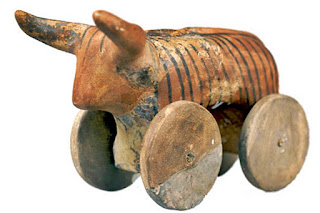Sunday, April 2, 2023
Cucuteni-Trypillian culture in Eastern Europe
The Cucuteni-Trypillian culture (known as Cucuteni in Romanian and Trypilska in Ukrainian), is a Neolithic–Eneolithic archaeological culture (circa 6000 to 3500 BC) in Eastern Europe.
It extends from the Carpathian Mountains to the Dniester and Dnieper regions, centered on modern-day Moldova and covering substantial parts of western Ukraine and northeastern Romania, encompassing an area of 350,000km2.
The culture was initially named after the village of Cucuteni in Iași County, Romania. In 1884, Teodor Burada, after having seen ceramic fragments in the gravel used to maintain the road from Târgu Frumos to Iași, investigated the quarry in Cucuteni from where the material was mined, where he found fragments of pottery and terracotta figurines. Burada and other scholars from Iași, began the first excavations at Cucuteni in the spring of 1885. Their findings were published in 1885 and 1889, and presented in two international conferences in 1889, both in Paris.
At the same time, the first Ukrainian sites ascribed to the culture were discovered by Vincent Chvojka, Czech amateur archeologist. The year of his discoveries has been variously claimed as 1893, 1896 and 1887. Subsequently, Vincent Chvojka presented his findings at the 11th Congress of Archaeologists in 1897, which is considered the official date of the discovery of the Trypillian Culture in Ukraine.
The Cucuteni-Trypillian culture is commonly divided into an Early, Middle, Late period, with varying smaller sub-divisions marked by changes in settlement and material culture. A key point of contention lies in how these phases correspond to radiocarbon data.
Throughout the 2,750 years of its existence, the Cucuteni-Trypillian culture was fairly stable and static; however, there were changes that took place. These include the basic economic conditions of the culture, the development of trade, interaction with other cultures, and the apparent use of barter tokens, an early form of money.
Members of the Cucuteni-Trypillian culture shared common features with other Neolithic societies, including: An almost nonexistent social stratification; Lack of a political elite; Rudimentary economy, most likely a subsistence or gift economy; Pastoralists and subsistence farmers.
The Cucuteni-Trypillian culture was a society of subsistence farmers. Cultivating the soil (using an ard or scratch plough), harvesting crops and tending livestock was probably the main occupation for most people. Typically for a Neolithic culture, the vast majority of their diet consisted of cereal grains. They cultivated club wheat, oats, rye, proso millet, barley and hemp, which were probably ground and baked as unleavened bread in clay ovens or on heated stones in the home. They also grew peas and beans, apricot, cherry plum and wine grapes – though there is no solid evidence that they actually made wine. There is also evidence that they may have kept bees.
The zooarchaeology of Cucuteni-Trypillian sites indicate that the inhabitants practiced animal husbandry. Their domesticated livestock consisted primarily of cattle, but included smaller numbers of pigs, sheep and goats. There is evidence, based on some of the surviving artistic depictions of animals from Cucuteni-Trypillian sites, that the ox was employed as a draft animal.
Hunting supplemented the Cucuteni-Trypillian diet. They used traps to catch their prey, as well as various weapons, including the bow and arrow, the spear, and clubs. To help them in stalking game, they sometimes disguised themselves with camouflage. Remains of game species found at Cucuteni-Trypillian sites include red deer, roe deer, aurochs, wild boar, fox and brown bear.
The Cucuteni-Trypillian culture is known by its distinctive settlements, architecture, intricately decorated pottery and anthropomorphic and zoomorphic figurines, which are preserved in archaeological remains. At its peak it was one of the most technologically advanced societies in the world at the time, developing new techniques for ceramic production, housing building and agriculture, and producing woven textiles.
In terms of overall size, some of Cucuteni-Trypillian sites, such as Talianki (with a population of 15,000 and covering an area of 335 hectares) in the province of Uman Raion, Ukraine, are as large as (or perhaps even larger than) the more famous city-states of Sumer in the Fertile Crescent, and these Eastern European settlements predate the Sumerian cities by more than half of a millennium.
These settlements underwent periodical acts of destruction and re-creation, as they were burned and then rebuilt every 60–80 years. Some scholars have theorized that the inhabitants of these settlements believed that every house symbolized an organic, almost living, entity.
Most Cucuteni-Trypillian pottery was hand coiled from local clay. Long coils of clay were placed in circles to form first the base and then the walls of the vessel. Once the desired shape and height of the finished product was built up the sides would then be smoothed to create a seamless surface. This technique was the earliest form of pottery shaping and the most common in the Neolithic; however, there is some evidence that they also used a primitive type of slow-turning potter's wheel, an innovation that did not become common in Europe until the Iron Age.
Characteristically vessels were elaborately decorated with swirling patterns and intricate designs. Sometimes decorative incisions were added prior to firing, and sometimes these were filled with colored dye to produce a dimensional effect. In the early period, the colors used to decorate pottery were limited to a rusty-red and white. Later, potters added additional colors to their products and experimented with more advanced ceramic techniques. The pigments used to decorate ceramics were based on iron oxide for red hues, calcium carbonate, iron magnetite and manganese Jacobsite ores for black, and calcium silicate for white.
Very few researchers, believe that the Cucuteni culture used the wheel with wagons. However, only miniature models of animals on 4 wheels have been found, and they date to the first half of the fourth millennium BC. Such models are often thought to have been children's toys; nevertheless, the do convey the idea that objects could be pulled on wheels. Up to now there is no whatever evidence for wheels used with real wagons.
Some Cucuteni-Trypillian communities have been found that contain a special building located in the center of the settlement, which archaeologists have identified as sacred sanctuaries. Artifacts have been found inside these sanctuaries, some of them having been intentionally buried in the ground within the structure, that are clearly of a religious nature, and have provided insights into some of the beliefs, and perhaps some of the rituals and structure, of the members of this society. Additionally, artifacts of an apparent religious nature have also been found within many domestic Cucuteni-Trypillian homes.
Many of these artifacts are clay figurines or statues. Archaeologists have identified many of these as fetishes or totems, which are believed to be imbued with powers that can help and protect the people who look after them. These Cucuteni-Trypillian figurines have become known popularly as goddesses; however, this term is not necessarily accurate for all female anthropomorphic clay figurines, as the archaeological evidence suggests that different figurines were used for different purposes (such as for protection), and so are not all representative of a goddess. There have been so many of these figurines discovered in Cucuteni-Trypillian sites that many museums in eastern Europe have a sizeable collection of them, and as a result, they have come to represent one of the more readily identifiable visual markers of this culture to many people.
There is a debate among scholars regarding how the end of the Cucuteni-Trypillian culture took place.
According to some proponents of the Kurgan hypothesis of the origin of Proto-Indo-Europeans, and in particular the archaeologist Marija Gimbutas, the Cucuteni-Trypillian culture was destroyed by force. Arguing from archaeological and linguistic evidence, Gimbutas concluded that the people of the Kurgan culture (a term grouping the Yamna culture and its predecessors) of the Pontic–Caspian steppe, being most likely speakers of the Proto-Indo-European language, effectively destroyed the Cucuteni-Trypillian culture in a series of invasions undertaken during their expansion to the west. Based on this archaeological evidence Gimbutas saw distinct cultural differences between the patriarchal, warlike Kurgan culture and the more peaceful matriarchal Cucuteni-Trypillian culture, which she argued was a significant component of the "Old European cultures" which finally met extinction in a process visible in the progressing appearance of fortified settlements, hillforts, and the graves of warrior-chieftains, as well as in the religious transformation from the matriarchy to patriarchy, in a correlated east-west movement. Accordingly, these proponents of the Kurgan hypothesis hold that this invasion took place during the third wave of Kurgan expansion between 3000-2800 BC, permanently ending the Cucuteni-Trypillian culture.
In the 1990s and 2000s, another theory regarding the end of the Cucuteni-Trypillian culture emerged based on climatic change that took place at the end of their culture's existence that is known as the Blytt–Sernander Sub-Boreal phase. Beginning around 3200 BC, the earth's climate became colder and drier than it had ever been since the end of the last Ice age, resulting in the worst drought in the history of Europe since the beginning of agriculture. The Cucuteni-Trypillian culture relied primarily on farming, which would have collapsed under these climatic conditions in a scenario similar to the Dust Bowl of the American Midwest in the 1930s. According to that theory, the neighboring Yamna culture people were pastoralists, and were able to maintain their survival much more effectively in drought conditions. This has led some scholars to come to the conclusion that the Cucuteni-Trypillian culture ended not violently, but as a matter of survival, converting their economy from agriculture to pastoralism, and becoming integrated into the Yamna culture.










